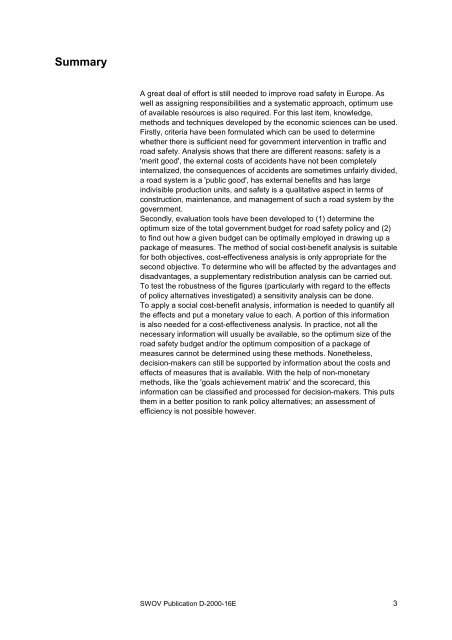Economic evaluation of road safety measures - Swov
Economic evaluation of road safety measures - Swov
Economic evaluation of road safety measures - Swov
You also want an ePaper? Increase the reach of your titles
YUMPU automatically turns print PDFs into web optimized ePapers that Google loves.
Summary<br />
A great deal <strong>of</strong> effort is still needed to improve <strong>road</strong> <strong>safety</strong> in Europe. As<br />
well as assigning responsibilities and a systematic approach, optimum use<br />
<strong>of</strong> available resources is also required. For this last item, knowledge,<br />
methods and techniques developed by the economic sciences can be used.<br />
Firstly, criteria have been formulated which can be used to determine<br />
whether there is sufficient need for government intervention in traffic and<br />
<strong>road</strong> <strong>safety</strong>. Analysis shows that there are different reasons: <strong>safety</strong> is a<br />
'merit good', the external costs <strong>of</strong> accidents have not been completely<br />
internalized, the consequences <strong>of</strong> accidents are sometimes unfairly divided,<br />
a <strong>road</strong> system is a 'public good', has external benefits and has large<br />
indivisible production units, and <strong>safety</strong> is a qualitative aspect in terms <strong>of</strong><br />
construction, maintenance, and management <strong>of</strong> such a <strong>road</strong> system by the<br />
government.<br />
Secondly, <strong>evaluation</strong> tools have been developed to (1) determine the<br />
optimum size <strong>of</strong> the total government budget for <strong>road</strong> <strong>safety</strong> policy and (2)<br />
to find out how a given budget can be optimally employed in drawing up a<br />
package <strong>of</strong> <strong>measures</strong>. The method <strong>of</strong> social cost-benefit analysis is suitable<br />
for both objectives, cost-effectiveness analysis is only appropriate for the<br />
second objective. To determine who will be affected by the advantages and<br />
disadvantages, a supplementary redistribution analysis can be carried out.<br />
To test the robustness <strong>of</strong> the figures (particularly with regard to the effects<br />
<strong>of</strong> policy alternatives investigated) a sensitivity analysis can be done.<br />
To apply a social cost-benefit analysis, information is needed to quantify all<br />
the effects and put a monetary value to each. A portion <strong>of</strong> this information<br />
is also needed for a cost-effectiveness analysis. In practice, not all the<br />
necessary information will usually be available, so the optimum size <strong>of</strong> the<br />
<strong>road</strong> <strong>safety</strong> budget and/or the optimum composition <strong>of</strong> a package <strong>of</strong><br />
<strong>measures</strong> cannot be determined using these methods. Nonetheless,<br />
decision-makers can still be supported by information about the costs and<br />
effects <strong>of</strong> <strong>measures</strong> that is available. With the help <strong>of</strong> non-monetary<br />
methods, like the 'goals achievement matrix' and the scorecard, this<br />
information can be classified and processed for decision-makers. This puts<br />
them in a better position to rank policy alternatives; an assessment <strong>of</strong><br />
efficiency is not possible however.<br />
SWOV Publication D-2000-16E 3
















